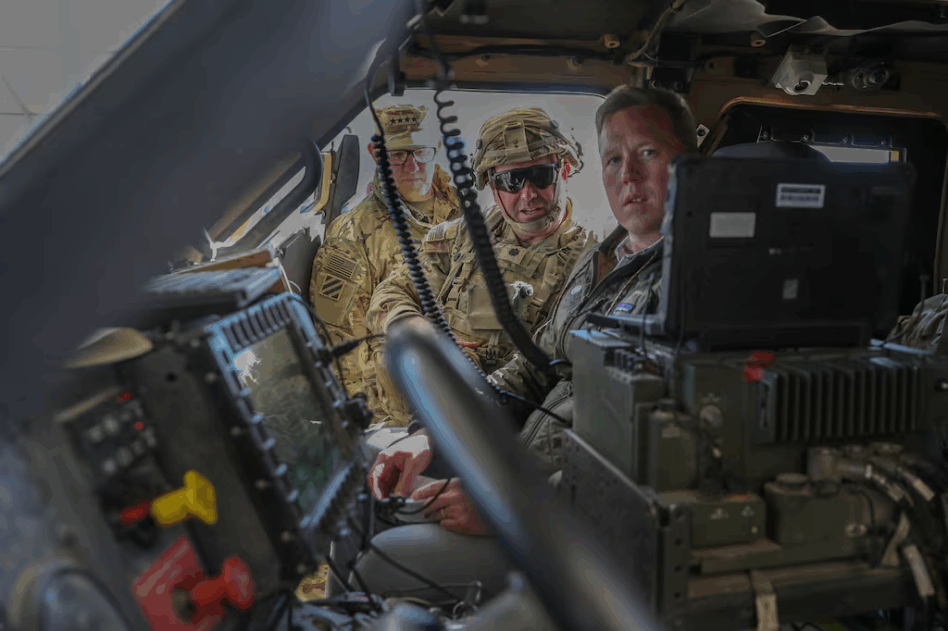In case you missed it, Anduril announced late Friday that they’d been awarded a $99.6M, 11-month OTA contract to spearhead a next-generation command and control (NGC2) prototype for the 4th Infantry Division of the Army.
The defense megalith will lead an all-star team—including heavyweights like Palantir, Govini, Microsoft, and Striveworks—in building an end-to-end system that “modernize[s] the service’s communications and networking technologies,” according to the company.
That’s all fine and good (and an impressively quick timeline), but we wanted to do a deeper dive. What’s the history of NGC2? What’s the Army’s vision for the program? And what happens after the year is up?
Race to integrate: NGC2 is the Army’s answer to Joint All-Domain Command and Control (JADC2), the military’s effort to integrate information, data, and decision-making across all domains (land, air, sea, space, and cyber) and services (Army, Navy, Air Force, Marine Corps, and Space Force).
Think of it as a single, ultra-smart, AI-boosted brain that powers everything the DoD does.
- The concept was introduced during the first Trump administration in 2020, but faced major hurdles due to the very thing it sought to fix: siloes between the services and a lack of centralized funding.
- The DoD published a classified JADC2 Strategy and formed a JADC2 Cross-Functional Team in 2021 to coordinate between services. An implementation plan was formalized in 2022.
- Historically, the Army alone uses a cobbled-together C2 system comprising 17 programs of record.
From 2021 to 2023, each service developed its own version of the program, including:
- Project Overmatch for the Navy
- Project Convergence/NGC2 for the Army
- Advanced Battle Management System (ABMS) for the Air Force
The Army unveiled NGC2 in the spring of 2024, and in September 2024, the service issued an initial request for information (RFI). Here’s what’s happened since:
- Late 2023: Anduril began NGC2 experimentation.
- September 2024: Anduril won an initial one-year OTA for base work on NGC2 worth up to $24M as part of Project Convergence (later increased to $43M, according to HigherGov data).
- January 2025: The Army issued another RFI for NGC2
- March-April 2025: NGC2 prototypes were tested at Project Convergence.
- April 2025: NGC2 was established as a program office.
- July 2025: Anduril won the nearly $100M OTA.
With this new award, Anduril has been charged with leading a team of ultra-powerful defense tech companies in building “an ecosystem that can rapidly integrate a range of technologies into a singular architecture so that soldiers can access various kinds of compute, communications, and information processing capabilities all at once,” the company said.
That means Anduril and friends will need to integrate everything from traditional hardware to drones and sensors into open-architecture software infrastructure to make sure that soldiers stay connected, informed, and aware of threats. And if the team fails, that’s on the $30.5B defense darling.
- The foundation of the system will be Anduril’s Lattice Mesh C2 platform, which the DoD already uses.
- The prototype will integrate everything from “enemy locations, logistics and sustainment information, terrain mapping, tactical control measures, [to] weapons statuses,” according to Anduril.
The prototype will be delivered to the 4th Infantry Division ASAP, and the Anduril team will start testing and iterating alongside soldiers.
In the running: But here’s the thing. Anduril’s prototype isn’t necessarily the end-all-be-all. Upon announcing the $99.6M OTA, the Army also said it would issue additional commercial solutions openings (CSOs) for more NGC2 prototypes for other divisions.
Army CTO Alex Miller told Tectonic that the whole idea of the team model and trying out more prototypes is to encourage healthy competition. “Rather than being stuck with one prime forever, we have more flexibility and negotiating leverage to incentivize good behavior and disincentivize bad behaviors,” he said.
Plus, it places responsibility on the team lead for success, and allows smaller companies to participate in the program—and interact directly with the Army.
“The teaming arrangements are unique because historically we’d have a lead systems integrator (LSI) that has a unique agreement with the Government and we would not be able to interface with the small tech providers,” Miller added, “It’s like a rugby team—coach can interface with the players but the team leader has to lead.”
Scale up: Anduril & co will build out their prototype with the 4th Infantry Division and “if it’s great and works [the Army] can move it to the production contracts,” Miller said. And if another prototype emerges as better, they can move forward with that.
The Army will issue more OTAs for prototypes for other divisions, including the 25th Infantry Division and III Corps Headquarters, within the year. Miller expects we’ll see three more OTAs.
Building blocks: Fundamentally, he said, this approach reflects the way NGC2 has to work.
“When you have something that big and beefy you risk it becoming so unwieldy as to not be manageable because a single prime contractor or lead systems integrator treats it like a black box,” he said, “[This] approach for NGC2 lets us stand up the infrastructure, stand up the data layer, and immediately get feedback from users and continuously iterate on each component.”
Now, let’s see if Anduril and Palantir know how to play nicely with others.

